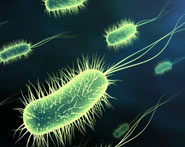


 النبات
النبات
 الحيوان
الحيوان
 الأحياء المجهرية
الأحياء المجهرية
 علم الأمراض
علم الأمراض
 التقانة الإحيائية
التقانة الإحيائية
 التقنية الحيوية المكروبية
التقنية الحيوية المكروبية
 التقنية الحياتية النانوية
التقنية الحياتية النانوية
 علم الأجنة
علم الأجنة
 الأحياء الجزيئي
الأحياء الجزيئي
 علم وظائف الأعضاء
علم وظائف الأعضاء
 الغدد
الغدد
 المضادات الحيوية
المضادات الحيوية|
أقرأ أيضاً
التاريخ: 6-9-2017
التاريخ: 24-11-2015
التاريخ: 22-11-2015
التاريخ: 23-11-2015
|
Hyaline cartilage is so called because it is transparent (hyalos = glass).
Its intercellular substance appears to be homogeneous, but using special techniques it can be shown that many collagen fibres are present in the matrix. The fibres are arranged so that they resist tensional forces. Hyaline cartilage has been compared to a tyre. The ground substance (corresponding to the rubber of the tyre) resists compressive forces, while the collagen fibres (corresponding to the treads of the tyre) resist tensional forces.
In haematoxylin and eosin stained preparations, the matrix is stained blue, i.e., it is basophilic. However, the matrix just under the perichondrium is acidophilic .Towards the centre of a mass of hyaline cartilage the chondrocytes are large and are usually present in groups (of two or more). The groups are formed by division of a single parent cell. The cells tend to remain together as the dense matrix prevents their separation. Groups of cartilage cells are called cell-nests (or isogenous cell groups). Towards the periphery of the cartilage, the cells are small and elongated in a direction parallel to the surface. Just under the perichondrium the cells become indistinguishable from fibroblasts.
Immediately around lacunae housing individual chondrocytes, and around cell nests the matrix stains deeper than elsewhere giving the appearance of a capsule. This deep staining matrix is newly formed and is called the territorial matrix or lacunar capsule. In contrast the pale staining matrix separating cell nests is the interstitial matrix.
Calcification of hyaline cartilage is often seen in old people. The costal cartilages or the large cartilages of the larynx are commonly affected. In contrast to hyaline cartilage, elastic cartilage and fibrocartilage do not undergo calcification. Although articular cartilage is a variety of hyaline cartilage, it does not undergo calcification or ossification.
Distribution of Hyaline Cartilage
- Costal cartilages: These are bars of hyaline cartilage that connect the ventral ends of the ribs to the sternum, or to adjoining costal cartilages. They show the typical structure of hyaline cartilage described above. The cellularity of costal cartilage decreases with age.
- Articular cartilage: The articular surfaces of most synovial joints are lined by hyaline cartilage. These articular cartilages provide the bone ends with smooth surfaces between which there is very little friction. They also act as shock absorbers. Articular cartilages are not covered by perichondrium. Their surface is kept moist by synovial fluid that also provides nutrition to them.
Other sites where hyaline cartilage is found:
- The skeletal framework of the larynx is formed by a number of cartilages. Of these the thyroid cartilage, the cricoid cartilage and the arytenoid cartilage are composed of hyaline cartilage.
- The walls of the trachea and large bronchi contain incomplete rings of cartilage. Smaller bronchi have pieces of cartilage of irregular shape in their walls.
- Parts of the nasal septum and the lateral wall of the nose are made up of pieces of hyaline cartilage.
- In growing children long bones consist of a bony diaphysis (corresponding to the shaft) and of one or more bony epiphyses (corresponding to bone ends or projections). Each epiphysis is connected to the diaphysis by a plate of hyaline cartilage called the epiphyseal plate. This plate is essential for bone growth.




|
|
|
|
للتخلص من الإمساك.. فاكهة واحدة لها مفعول سحري
|
|
|
|
|
|
|
العلماء ينجحون لأول مرة في إنشاء حبل شوكي بشري وظيفي في المختبر
|
|
|
|
|
|
|
قسم الشؤون الفكرية يحتفي بإصدار العدد الألف من نشرة الكفيل
|
|
|